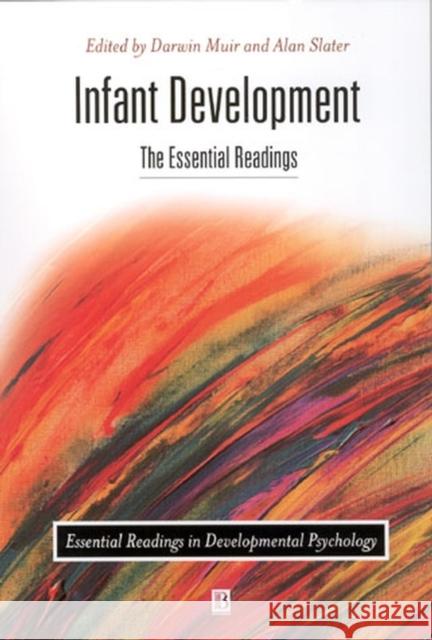Infant Development » książka



Infant Development
ISBN-13: 9780631217466 / Angielski / Twarda / 2000 / 404 str.
Infant Development
ISBN-13: 9780631217466 / Angielski / Twarda / 2000 / 404 str.
(netto: 627,99 VAT: 5%)
Najniższa cena z 30 dni: 655,33
ok. 30 dni roboczych
Dostawa w 2026 r.
Darmowa dostawa!
Infant Development: The Essential Readings provides students with a selection of some of the key articles by key researchers in this core area of developmental psychology and introduces the reader to the field of infancy research and to some of the current, lively controversies within this area.
"What stands out is the excellent and up–to–date selection of essays in the volume on infant development which offered a very good balance between theory and empirical research." Infancia y Aprendizaje, vol 24(1), 2001.
"If you have the time, read it. If you do not have the time, find it somehow". Ruth Coppard, Educational Psychology in Practice, Vol 18, 2002
"Infant Development: The Essential Readings is accessible to the reader, illustrates the current work and controversies in the field, and shows diversity of research topics, according to the general definition of the parameters of the field. It is an informative source of information for anyone interested in learning about current research in infant developmental psychology. The editors have succeeded in the important task of providing an update on the research that has occurred in the past decade. Very few books with comparable information have been published since the 1980s. Although there are many volumes that focus on a narrower aspect of recent infant developmental research and many more than explain theories and applications of research to parents, this book discusses the theories and provides comprehensive and contextual information on a wider range of research in the field." Sarah Duman, University of Southern California, APA Review of Books, December 2003
Preface.
Acknowledgments.
Introduction.
Infancy Research: History and Methods: Darwin Muir and Alan Slater.
Part I: Theoretical Issues.
Introduction.
Why Do Infants Do What They Do?.
Introduction.
1. Shifting the Focus From What to Why: C. Rovee–Collier.
The Origins of Knowledge: Nature versus Nurture.
Introduction.
2. Nativism, Empiricism, and the Origins of Knowledge: E.S. Spelke.
Connectionist Modeling.
Introduction.
3. Connectionist Modeling and Infant Development: D.Mareschal.
Part II: Sensation and Perception.
Introduction.
Fetal Sensitivity to Touch.
Introduction.
4. Maturation of Human Fetal Responses to Vibroacoustic Stimulation: B.S. Kisilevsky, D.W. Muir, and J.A. Low.
Early Visual perception.
Introduction.
5. Visual perception in the Young Infant: Early Organization and Rapid Learning: A. Slater.
Intermodal Perception.
Introduction.
6. Increasing Specificity in the Development of Intermodal Perception: L. Bahrick. Social Perception.
Introduction.
7. Look at Me: Five–Month–Old Infants′ Sensitivity to Very Small Deviations in Eye–Gaze During Social Interactions: L.A. Symons, S.M. Hains, and D.W. Muir.
Speech Perception.
Introduction.
8. Becoming a Native Listener: J.F. Werker.
Part III: Cognitive Development.
Introduction.
Newborn Imitation.
Introduction.
9a. Imitation of Facial and Manual Gestures by Human Neonates: A.N. Meltzoff, and M.K Moore.
9b. Resolving the Debate about Early Imitation: A.N. Meltzoff, and M.K. Moore.
Infant Counting.
Introduction.
10. Addition and Subtraction by Human Infants: K. Wynn.
Learning About the Physical World.
Introduction.
11. How Do Infants learn About the Physical World? R. Baillargeon.
The A–not–B Error.
Introduction.
12. Why Do Infants Make A–not–B Errors in a Search Task, Yet Show Memory for the Location of Hidden Objects in a Nonsearch Task? A. Ahmed, and T. Ruffman.
Predicting Later Intelligence.
Introduction.
13. Why Does Infant Attention Predict Adolescent Intelligence? M. Sigman, S.E. Cohen, and L. Beckwith.
Part IV: Social Development and Communication:.
Introduction.
Infant–Directed Speech.
Introduction.
14. Infant Responses to Prototypical melodic Contours in Parental Speech: M. Papou ek, M.H. Bornstein, C. Nuzzo, H. Papou ek, and D. Symmes.
15. Early Word Comprehension in 6–Moth–Olds: R. Tincoff, and P.W. Jusczyk.
Social Referencing.
Introduction.
16. Maternal Emotional Signaling: Its Effect on the Visual Cliff Behavior of 1–Year–Olds: J.F. Sorce, R.N. Emde, J. Campos, and M.D. Klinnert.
Infant Understanding of Others′ Intentions and Theory of Mind.
Introduction.
17. Fourteen–Through 18–Month–Old Infants.
Differentially Imitate Intentional and Accidental Actions: M. Carpenter, N. Akhtar, and M. Tomasello.
Social Attachments.
Introduction.
18. Stability and Transmission of Attachment across Three Generations: D. Benoit, and K. Parker.
Infants with Autism.
Introduction.
19. An Experimental Investigation of Social–Cognitive Abilities in Infants with Autism: Clinical Implications: T. Charman, J. Swettenham, S. Baron–Cohen, A. Cox, G. Baird, and A. Drew.
Index.
Darwin Muir is Professor of Psychology at Queen′s University, Ontario.
Alan Slater is Senior Lecturer in the School of Psychology at the University of Exeter.
They are co–editors of the recently published Blackwell Reader in Developmental Psychology.
Discoveries by researchers into infant development are some of the most exciting and important to be found in the study of human development, and they have been the subject of intense speculation and theorizing. Despite the fact that, as adults, we can remember little about the times and places when we acquired knowledge in infancy, that information does remain with us for the rest of our lives.
Infant Development: The Essential Readings introduces the reader to the field of infancy research and to some of the current, lively controversies within this area.
Each of the articles within the reader has been chosen to reflect the dynamic, changing nature of the subject and the diversity of research and thinking within the are of infant development. The articles have also been selected to be accessible to students at all levels. These articles are all by leading infancy researchers, and they are introduced and contextualized by the editors. Suggestions for further reading are made to give students an ideal starting point for exploration of the key topic in infant development.
1997-2025 DolnySlask.com Agencja Internetowa
KrainaKsiazek.PL - Księgarnia Internetowa









